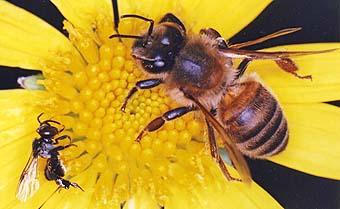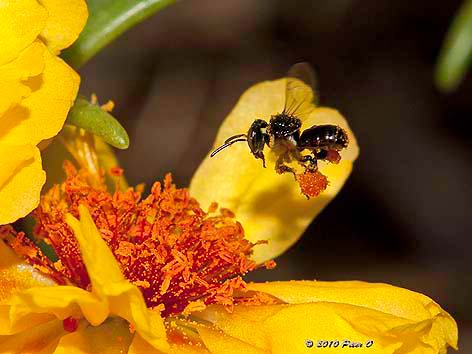What are stingless bees?
Australia has about ten species of small black stingless bees. They are about 4 mm long -- see the photo below of a stingless bee compared with a much larger commercial honeybee.

Some
species are black with white fur on their faces and sides. Other
species are black with tiny yellow markings on their backs. They build
resinous nests inside hollow trees.
Visit Aussie Bee's special galleries to see:
-- beautiful photos of stingless bees
-- spectacular videos of stingless bees
In which parts of Australia are stingless bees found?
Stingless bees are tropical. So they only thrive in warm areas of Australia such as Queensland, northern areas of WA and NT, and north-eastern areas of NSW. To find out more, read our article: Which Native Bees are in Your Area?
Can I keep Australian stingless bees?
Native stingless bees can be kept in a natural log or in a hive box in suitable parts of Australia. These bees are easy and safe to keep in your backyard but you need to learn about their special requirements. To find out more, read our article: How to Care for Your Nest of Australian Stingless Bees.
Where can I buy some Australian stingless bees?
Aussie Bee provides a list of many breeders who can supply hives of stingless native bees. It is important to buy a bee species and a hive design that suits your area. So have we grouped together the hive sellers whose bees suit various areas of Australia. Visit our hive sellers' page: Where to Buy Stingless Bees in Australia.
Visit Aussie Bee's special galleries to see:
-- beautiful photos of stingless bees
-- spectacular videos of stingless bees
 |
|
Above: One of the spectacular photos of stingless bees in our Photo Galleries.
This photo was taken by Peter O. |
In which parts of Australia are stingless bees found?
Stingless bees are tropical. So they only thrive in warm areas of Australia such as Queensland, northern areas of WA and NT, and north-eastern areas of NSW. To find out more, read our article: Which Native Bees are in Your Area?
Can I keep Australian stingless bees?
Native stingless bees can be kept in a natural log or in a hive box in suitable parts of Australia. These bees are easy and safe to keep in your backyard but you need to learn about their special requirements. To find out more, read our article: How to Care for Your Nest of Australian Stingless Bees.
Where can I buy some Australian stingless bees?
Aussie Bee provides a list of many breeders who can supply hives of stingless native bees. It is important to buy a bee species and a hive design that suits your area. So have we grouped together the hive sellers whose bees suit various areas of Australia. Visit our hive sellers' page: Where to Buy Stingless Bees in Australia.
| Can I harvest honey from Australian stingless bees? Stingless bees only produce small amounts of honey - less than one litre per year. However, this honey (known as Sugarbag) is delicious and tangy! It is possible to harvest small amounts of honey from suitable hives in warm parts of Australia. To find out more, read our article: Honey Production With Stingless Native Bees. |
No comments:
Post a Comment